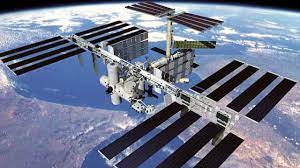
space exploration
The International Space Station is a large spacecraft in orbit around Earth. It serves as a home where crews of astronauts and cosmonauts live. The space station is also a unique science laboratory. Several nations worked together to build and use the space station. The space station is made of parts that were assembled in space by astronauts. It orbits Earth at an average altitude of approximately 250 miles. It travels at 17,500 mph. This means it orbits Earth every 90 minutes.
History:
The first piece of the International Space Station was launched in November 1998. A Russian rocket launched the Russian Zarya (zar EE uh) control module. About two weeks later, the space shuttle Endeavour met Zarya in orbit. The space shuttle was carrying the U.S. Unity node. The crew attached the Unity node to Zarya. More pieces were added over the next two years before the station was ready for people to live there. The first crew arrived on November 2, 2000. People have lived on the space station ever since. More pieces have been added over time. NASA and its partners from around the world completed construction of the space station in 2011.
Importance:
The mission of the International Space Station is to enable long-term exploration of space and provide benefits to people on Earth. . NASA is using the space station to learn more about living and working in space. These lessons will make it possible to send humans farther into space than ever before. The laboratories on the Space Station will allow for innovative space research projects to improve our understanding of the Earth’s environment and the universe in which we live. The Space Station will also serve as the gateway to new frontiers in human space exploration, a place where we can learn how to live and work “off planet.” It will allow for the study of long-term effects of weightlessness on the human body and as a test bed to understand what adjustments need to be made to current methods before astronauts are sent to Mars and beyond. In addition, it will allow for critical research in fluids, combustion, life support systems and the radiation environment, which is needed for future human space exploration.
Parts of Space Station:
In addition to the laboratories where astronauts conduct science research, the space station has many other parts. The first Russian modules included basic systems needed for the space station to function. They also provided living areas for crew members. Modules called “nodes” connect parts of the station to each other. Stretching out to the sides of the space station are the solar arrays. These arrays collect energy from the sun to provide electrical power. The arrays are connected to the station with a long truss. On the truss are radiators that control the space station’s temperature. Robotic arms are mounted outside the space station. The robot arms were used to help build the space station. Those arms also can move astronauts around when they go on spacewalks outside. Other arms operate science experiments. Astronauts can go on spacewalks through airlocks that open to the outside. Docking ports allow other spacecraft to connect to the space station. New crews and visitors arrive through the ports. Astronauts fly to the space station on the Russian Soyuz. Robotic spacecraft use the docking ports to deliver supplies.
Why space exploration is important?
Space exploration is indeed important in many ways now. Some of the importance of space exploration can be seen through the following few points:
In addition to the laboratories where astronauts conduct science research, the space station has many other parts. The first Russian modules included basic systems needed for the space station to function. They also provided living areas for crew members. Modules called “nodes” connect parts of the station to each other. Stretching out to the sides of the space station are the solar arrays. These arrays collect energy from the sun to provide electrical power. The arrays are connected to the station with a long truss. On the truss are radiators that control the space station’s temperature. Robotic arms are mounted outside the space station. The robot arms were used to help build the space station. Those arms also can move astronauts around when they go on spacewalks outside. Other arms operate science experiments. Astronauts can go on spacewalks through airlocks that open to the outside. Docking ports allow other spacecraft to connect to the space station. New crews and visitors arrive through the ports. Astronauts fly to the space station on the Russian Soyuz. Robotic spacecraft use the docking ports to deliver supplies.
Another thing that is really important in this regard is that if we want to defend and protect our planet then we need to study about our space and our cosmic neighborhood. All the social and environmental progress in the world won’t help us if an asteroid impacts the Earth. We have to explore space to find and study the asteroids and comets in our cosmic neighborhood if we want to make sure we can defend our planet if an object ever heads our way.
Space is an inspiration to me and too many other kids as well but due to lack of resources not everyone gets the opportunity to fulfill their dreams. Not every child who dreams of becoming an astronaut will get that opportunity. This is a sad truth that many of us know from experience. But to be inspired to aim for something so grand gives kids the motivation to study hard and gain skills in science, engineering, medicine, or other fields that benefit humanity and directly help overcome problems that we face as a species.
Conclusion:
Today, the importance of space exploration has increased a lot. The exposure that it gives about space is what every Nation needs to be progressed.in short, we can categorize the benefits of space exploration into three fundamental areas as innovation culture and inspiration and new means to address global challenges.
By: Aamna Saleem Khan
Write and Win: Participate in Creative writing Contest & International Essay Contest and win fabulous prizes.


